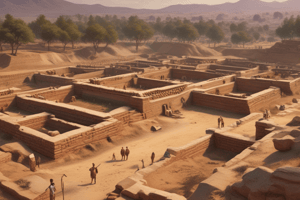Podcast
Questions and Answers
What layout was characteristic of cities like Harappa and Mohenjo-Daro?
What layout was characteristic of cities like Harappa and Mohenjo-Daro?
- Grid pattern (correct)
- Circular layout
- Radial layout
- Chaotic layout
What types of goods were primarily exported by the Sindhu civilization?
What types of goods were primarily exported by the Sindhu civilization?
- Ceramics and glass
- Wood and spices
- Cotton textiles and beads (correct)
- Wheat and livestock
Which of the following best describes the drainage system in Sindhu civilization?
Which of the following best describes the drainage system in Sindhu civilization?
- No drainage system
- Advanced covered drains (correct)
- Culvert systems only
- Basic open channels
Which deity was NOT worshiped in the Sindhu civilization?
Which deity was NOT worshiped in the Sindhu civilization?
What type of pottery is associated with the Sindhu civilization?
What type of pottery is associated with the Sindhu civilization?
Which of the following was a potential factor in the decline of the Sindhu civilization?
Which of the following was a potential factor in the decline of the Sindhu civilization?
What signifies the legacy of the Sindhu civilization?
What signifies the legacy of the Sindhu civilization?
What was a common characteristic of burial practices in the Sindhu civilization?
What was a common characteristic of burial practices in the Sindhu civilization?
Which material was primarily used in the construction of buildings in the Sindhu civilization?
Which material was primarily used in the construction of buildings in the Sindhu civilization?
What evidence is there of trade networks in the Sindhu civilization?
What evidence is there of trade networks in the Sindhu civilization?
Flashcards are hidden until you start studying
Study Notes
Sindhu सभ्यता
Urban Planning
- City Layout: Well-planned cities like Harappa and Mohenjo-Daro, featuring a grid pattern.
- Drainage System: Advanced drainage systems with covered drains and individual sanitation facilities.
- Building Materials: Use of standardized baked brick for construction, enhancing durability.
- Public Structures: Presence of large public baths (Great Bath), granaries, and storage facilities.
Trade Practices
- Trade Networks: Extensive trade routes connecting to Mesopotamia, Persia, and Central Asia.
- Currency: Possible use of standardized weights and measures, although no coins have been found.
- Goods Traded: Export of cotton textiles, beads, metals, and pottery; import of precious stones and metals.
- Marketplaces: Evidence of organized marketplaces for trade activities.
Religious Beliefs
- Deities: Worship of a Mother Goddess, nature deities, and possibly a horned male figure.
- Rituals: Limited evidence of elaborate rituals; emphasis on fertility and agricultural cycles.
- Burial Practices: Use of standardized burial methods with goods placed in graves, indicating beliefs in an afterlife.
- Symbols: Indus seals featuring animal motifs and script suggest a form of religious symbolism.
Art And Craft
- Pottery: Distinctive painted pottery with geometric and natural motifs.
- Sculpture: Small figurines, including terracotta dolls and seals depicting animals and deities.
- Metalwork: Skilled in metallurgy; production of bronze tools, weapons, and ornaments.
- Textiles: Advanced weaving techniques evidenced by cotton textiles and dyed fabrics.
Decline And Legacy
- Decline Factors: Possible causes include climate change, river shifts, invasions, and economic decline.
- Legacy: Influence on subsequent cultures in the Indian subcontinent, particularly in urban planning and craftsmanship.
- Cultural Aspects: Elements of Sindhu civilization persisted in later Indian cultures, including religious practices and agricultural techniques.
- Archaeological Importance: Continues to provide insights into early urbanization, trade, and social organization in ancient South Asia.
Urban Planning
- Harappa and Mohenjo-Daro feature a grid layout, showcasing advanced urban design.
- The drainage system includes covered drains and personal sanitation facilities, emphasizing hygiene.
- Standardized baked bricks were utilized for construction, ensuring uniformity and longevity.
- Notable public structures include the Great Bath and granaries, indicating organized community facilities.
Trade Practices
- The civilization established extensive trade routes linking Mesopotamia, Persia, and Central Asia.
- Evidence suggests the use of standardized weights and measures for trade, despite a lack of coins.
- Key exports included cotton textiles, beads, metals, and pottery, while precious stones were imported.
- Organized marketplaces were present, facilitating structured trading activities.
Religious Beliefs
- Worship practices included a Mother Goddess, nature deities, and a possibly horned male figure.
- There is limited evidence of complex rituals, focusing more on fertility and agricultural cycles.
- Standardized burial practices saw goods included in graves, reflecting beliefs in the afterlife.
- Indus seals featured animal motifs and script, suggesting a system of religious symbolism.
Art And Craft
- The civilization is known for distinctive painted pottery adorned with geometric and natural themes.
- Sculptures featured small figurines like terracotta dolls and animal and deity seals.
- Craftsmanship in metallurgy included producing bronze tools, weapons, and decorative ornaments.
- Advanced textile techniques produced high-quality cotton textiles and dyed fabrics.
Decline And Legacy
- The decline is attributed to potential factors such as climate change, river shifts, invasions, and economic shifts.
- The Sindhu civilization significantly influenced later cultures in the Indian subcontinent, particularly in urban planning and craftsmanship.
- Cultural aspects, including religious practices and agricultural methods, persisted in Indian traditions.
- Ongoing archaeological studies provide insights into early urbanization, trade dynamics, and social organization in ancient South Asia.
Studying That Suits You
Use AI to generate personalized quizzes and flashcards to suit your learning preferences.



